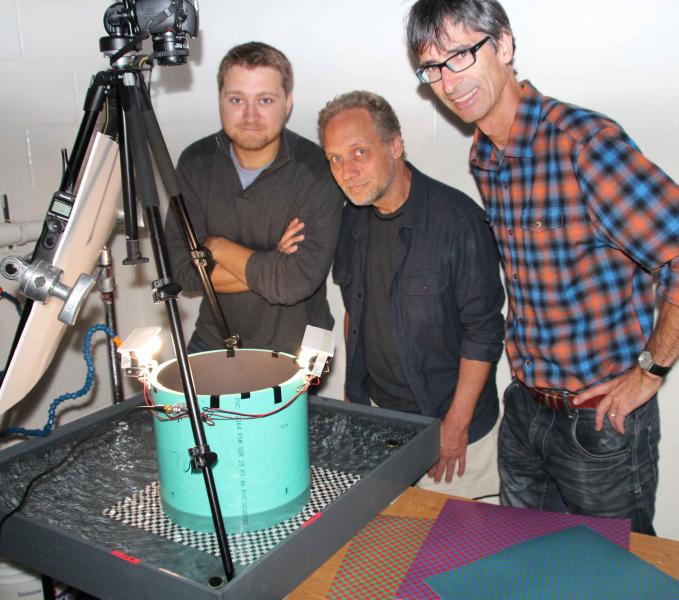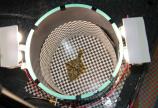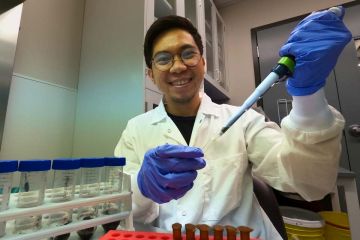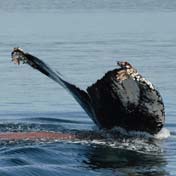What can fish see?
- John Threlfall

Artists and biologists collaborate on flatfish camouflage response study
The gap between the molecular basis of fish vision and the colour calibrations of a large-format printer may seem as wide as the space between the biology and visual arts departments, but a recent collaborative project brought the two much closer together.
It started when Tom Iwanicki, a MSc candidate studying starry flounder opsin genes with Biology professor John Taylor, contacted Cliff Haman, Senior Academic Assistantin Visual Arts, with a very basic question: what is colour?
“As biologists, we can ask ourselves questions about things like opsin genes and colour vision in fish and then, you would think, come up with various strategies to answer those questions” said Taylor. “But we quickly realized we lacked some very basic knowledge. For example, we wanted to print a particular colour on a sheet of paper. That is, we wanted the paper to reflect a particular wavelength of light. We had no idea how to do that, or even if it was possible. What about a second sheet of paper that reflects the same amount of light, but at a different wavelength? We asked the physics department, but they offered astronomers. So Tom focused on visual arts.”
The eyes have it
The experiment in question dealt with checkerboards and starry flounder camouflage. Starry flounders change the pattern on their back when they settle on a traditional black-and-white checkerboard—but what about one with red and green squares? Opsin genes encode the light receptors in the eye, and while humans are trichromatic—we have three different types of light receptors distributed among the ‘cone’ cells of our retina—fish have many more. “We know that species with only two cone cell opsins, like cats and dogs, can’t discriminate among as many colours as we can,” says Taylor. “We want to know if the surprisingly large fish opsin gene repertoire enhances their colour vision.”
Iwanicki’s two-year experiment also hoped to discover if opsins could be influenced by raising the fish in different light environments. “We’re very passionate about going from molecular data to actual behavior,” he explains. “We discovered these flatfish are capable of active camouflage—they can change colour quite quickly and convincingly—so we honed in on using differently coloured and patterned checkerboards as a model for studying vision in general.”
After living in UVic’s Outdoor Aquatic Unit for six weeks under broad-spectrum (as a control) and green-filtered (test) lighting that mimicked ocean conditions, Iwanicki set out to discover if the opsins changed under different light environments—and if this also influenced their ability to camouflage. Unfortunately, Taylor and Iwanicki were out of their depth when it came to creating the essential test patterns; fortunately, UVic offers diverse facilities for interdisciplinary research.
The theory of colour
Using the large-format printer in the Fine Arts building’s Studios for Integrated Media, Cliff Haman was able to create consistent, reliable prints that matched the spectrophotometer-measured colour intensities. “We work with colour daily, and our labs are very well-equipped for the creation and manipulation of digital media,” says Haman. “[Biology] had specific requirements for various swatch colours and luminosity values, particularly when laid out in checkerboard patterns. Our imaging software provides superb control and accuracy with such colour data.”
Haman also assisted with photo documentation, which required calibrated, diffuse lighting and a fairly complex camera installation. “It can all boggle the mind of someone who’s not familiar with it,” admits Iwanicki. “Visual Arts wasn’t the first place that came to mind, but we luckily ended up going there. It’s just been fantastic.”
To be clear, the goal of the experiment was to see if the fish echoed the pattern, not the colour. “If we give them a red and green background, we’re not expecting the fish to turn red and green,” says Taylor. “Instead, we’re looking to see if they adapt to a smooth, mottled or disruptive pattern; the fish can do each of those things. If it recognizes a smooth pattern, it will turn a single colour, whereas mottled or disruptive patterns will result in a stippled or big-block colours.”
Final results
And the result? “They’re definitely camouflaging differently—which is quite exciting,” says Iwanicki. “As far as I know, no one has explored camouflage response as a way of figuring out what fish can and can’t see.”
Taylor is clearly pleased. “Obviously, we don’t know everything about vision, but if you think about the opsin repertoire as a toolkit, there’s way more tools in there than we expected,” he says. “The job of light sensitivity is much more diverse than we thought it was.”
For his part, Haman enjoys the opportunities offered by such interdisciplinary research. “When we collaborate in other environments, we’re actively exposed to new ways of thinking and doing—which to my mind is fertile soil for sprouting new ideas.”
Ultimately, Iwanicki is excited about how it all went. “A lot of research tends to reduce things down to their component parts, but if you can incorporate the bigger picture all in one study, that’s one of the more important avenues we need to be shifting towards,” he says. And while he may speaking about his individual experiment, his thoughts clearly apply to the unexpected pairing of Biology and Visual Arts. “And that is really cool and exciting.”
Photos
In this story
Keywords: wildlife, fish, research, art, biology
People: John Taylor, Cliff Haman






